Purpose
It is important to measure soil moisture in semi-arid regions because future models predict severe droughts and a decrease in rainfall events by up to 40%. The effects of management practices, such as reduced tillage, cover cropping, and manure application, have not been evaluated in the semi-arid and irrigated crop production area of Southern Idaho. In this study, we investigated the effects of cover crops, dairy manure, and tillage on soil physical characteristics (soil water storage, infiltration, runoff, saturated hydraulic conductivity, bulk density) and silage corn yield in silty loam soils. The objectives of this research were to: (a) determine if cover crops and dairy manure increased soil water storage, or if the cover crops were depriving the cash crop of water, (b) determine if infiltration, runoff, saturated hydraulic conductivity, and bulk density were influenced by cover crops and dairy manure, (c) determine if silage corn yield is affected by cover crops and dairy manure, and (d) determine if there are differences between tillage types.
What Did We Do?
This study was conducted at the USDA-ARS Northwest Irrigation and Soils Research Laboratory in Kimberly, Idaho. The experimental design was a split plot with four replicates and repeated measures, and the two main experiment treatments were tillage (strip till vs disk/chisel plow). The four sub-treatments were: (a) control (no cover crop or dairy manure), (b) cover crop only (CC only), (c) manure only (M only), and (d) cover crop with manure (CC + M). Treatments that did not receive manure received inorganic fertilizer to meet recommended crop needs based on spring soil tests. Inorganic fertilizer was only applied to manure treatments if spring soil tests indicated that additional nutrients were required. Stockpiled dairy manure was applied with a manure spreader at a rate of 30 ton per acre (dry weight) in the fall after corn silage harvest and incorporated by disking or left on the surface. Both the corn silage and the triticale were irrigated using handlines, as needed, during the water season, which was generally from mid-April through mid-October. Soil moisture was measured using a neutron probe throughout each growing season. Neutron probe measurements were collected every 6 inches to a maximum depth of 60 inches one to two times per month. Soil water storage (SWS) was calculated from 0 to 12 inches, 0 to 24 inches, and 0 to 60 inches using weighted depth increments. A Cornell Sprinkle Infiltrometer was used to measure infiltration and runoff rates, field saturated infiltrability, and rainfall before runoff in the middle of the growing season in 2020 prior to an irrigation event.
What Have We Learned?
From this research, we found that the use of winter cover crops and fall applied solid dairy manure did not improve soil water storage in the semi-arid and calcareous soils in Southern Idaho. Soil water storage tended to be lower in the CC + M plots (Figure 1). The CC + M plots were able to infiltrate more water prior to runoff than the control plots, suggesting that the CC + M plots are drier (Figure 2). Infiltration, runoff, and saturated hydraulic conductivity did not improve with the treatments and remained similar to the control plots. Although some research has shown improvements in soil moisture, soil physical properties, and dry biomass yield when using reduced tillage practices, there were no differences between reduced tillage and conventional tillage. Silage corn yields tended to be highest in the M only plots and lowest in the CC + M plots, however there were no treatment differences in three of the six years of the study (Figure 3). Using triticale as a winter cover crop would be beneficial to increase total dry biomass yields in dairy systems that would like to increase their forage production, however it is not advised if a producer is only looking to increase silage production.


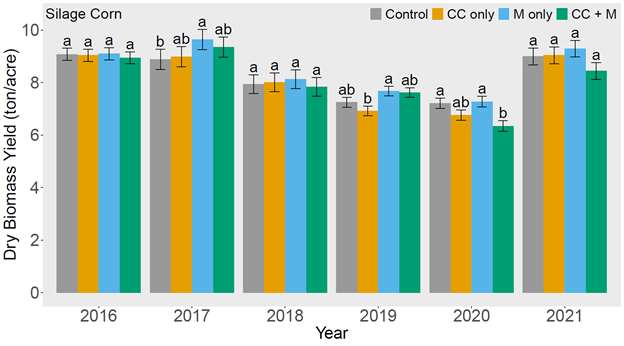
Future Plans
This spring, inversion tillage will be performed prior to planting silage corn to incorporate the dairy manure into the topsoil. Dairy manure has not been applied to the field since fall of 2020. Inorganic fertilizer will be applied if needed.
Authors
Presenting author
Kevin Kruger, Research Support Scientist, University of Idaho
Corresponding author
Jenifer L. Yost, Research Soil Scientist, USDA-ARS
Corresponding author email address
jenifer.yost@usda.gov
Additional authors
April B. Leytem, Research Soil Scientist, USDA-ARS; Robert S. Dungan, Research Microbiologist, USDA-ARS; Linda R. Schott, Nutrient and Waste Management Extension Specialist, University of Idaho
Additional Information
This research was presented at the virtual ASA, CSSA, SSSA International Annual Meeting in November of 2020. The link to the recorded presentation is found in the citation below. Although this research is not published in a scientific journal yet, we will be submitting a paper to Agricultural Water Management in early to mid 2022.
Yost, J.L., Leytem, A.B., Dungan, R.S., & Schott, L.R. (2020). The Use of Cover Crops and Manure to Retain Soil Moisture in Aridisols in Southern Idaho [Abstract]. ASA, CSSA and SSSA International Annual Meetings (2020) | Virtual, Phoenix, AZ.
https://scisoc.confex.com/scisoc/2020am/meetingapp.cgi/Paper/126244
Acknowledgements
The authors would like to thank Joy Lynn Barsotti for collecting the neutron probe measurements.


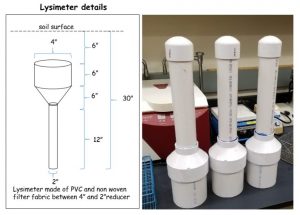

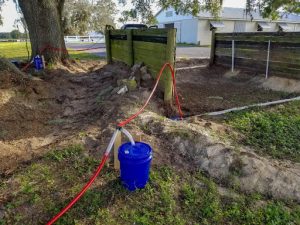
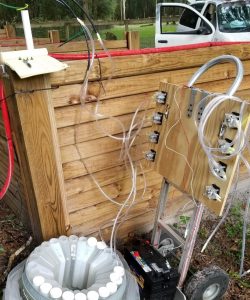
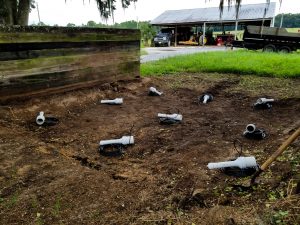




 What did we do?
What did we do?

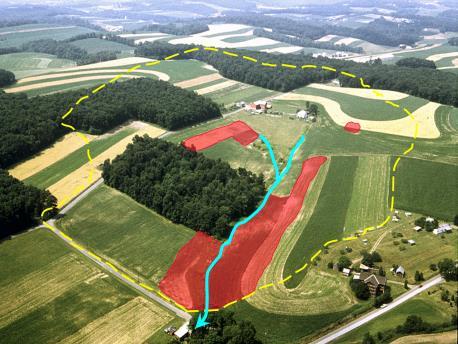
 What Did We Do?
What Did We Do?
